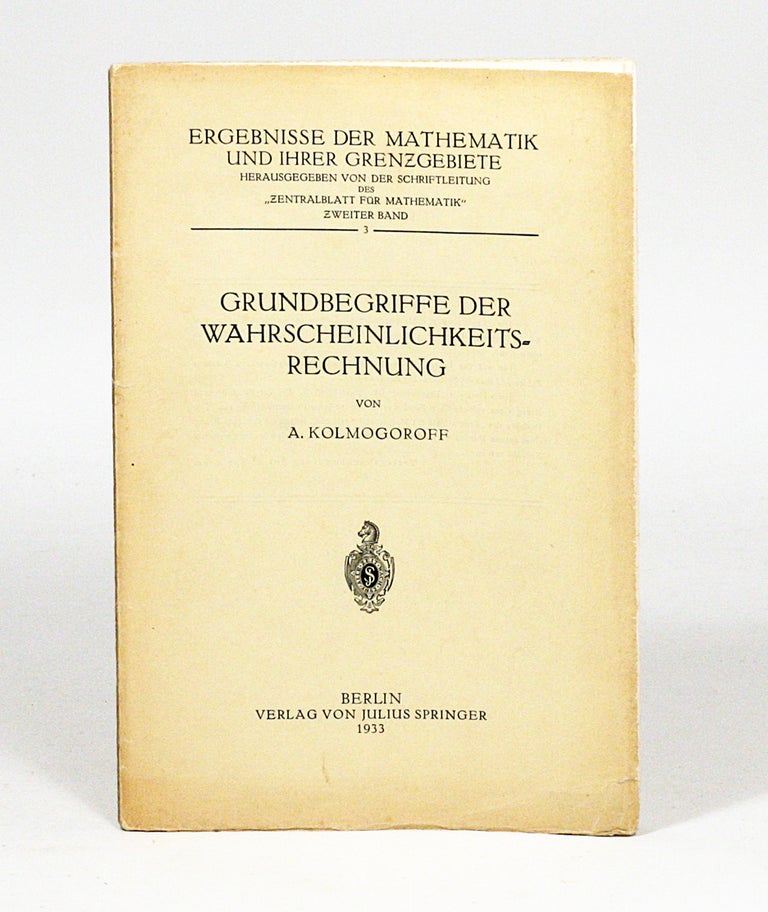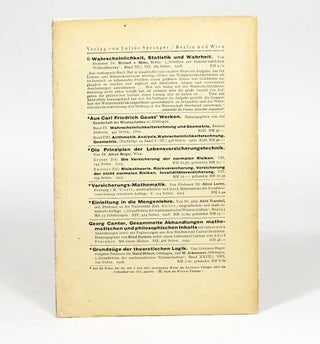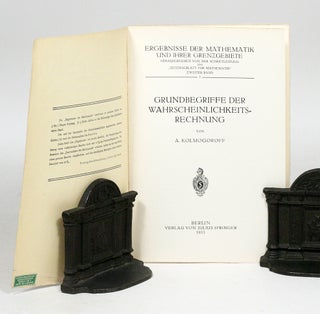Grundbegriffe Der Wahrscheinlichkeitsrechnung
“He [Thomas Hobbes] was … 40 yeares old before he looked on Geometry, which happened accidentally. Being in a Gentleman’s Library …, Euclid’s Elements lay open, and ‘twas the 47 E. libri I [i.e., the Pythagorean Theorem]. He read the proposition. ‘By G___,’ sayd he (he would now and then sweare an emphaticall Oath by way of emphasis), ‘this is impossible!’ So he reads the demonstration of it, which referred him back to such a proposition; which proposition he read. That referred him back to another, which he also read. Et sic deinceps [and so going forward], that at last he was demonstratively convinced of that trueth. This made him in love with Geometry.” — Aubrey’s “Brief Lives
THE FIRST EDITION, IN ITS ORIGINAL WRAPPERS, OF KOLMOGOROV’S FAMOUS PAPER PUTTING PROBABILITY THEORY ON A FIRM AXIOMATIC BASIS.
A formal system is a set of precisely-specified definitions, axioms, and rules of inference relating to a particular domain (such as geometry or arithmetic) that allow the rigorous development of theorems within that domain. Such systems replace vague and intuitive conceptions of a domain, or empirical rules of thumb, with rigorous standards of proof. The first formal system to be developed in the West was of course the system set forth in Euclid’s Elements (see quotation above). Recognizing in that system, or at least in idealized versions of it, the gold standard of rigor, mathematicians in the late nineteenth and twentieth centuries began trying to develop comparable systems outside the domain of geometry. Peano, for example, famously developed an axiomatic basis for natural-number arithmetic, Zermelo axiomatized set theory, and others sought to develop formal systems for symbolic logic and real-number arithmetic. In the meantime, Hilbert and others sought to refine Euclidean geometry in a way that would eliminate the unstated assumptions that underlie many of Euclid’s theorems and constructions. Still others, perhaps stretching matters a trifle, attempted to axiomatize ethics, theology, and other branches of metaphysics.
In a famous talk to a mathematical Congress in 1900, Hilbert proposed twenty-three problems that mathematicians should endeavor to solve in the twentieth century. His sixth problem challenged his listeners to develop a way “to treat in the same manner [as geometry], by means of axioms, those physical sciences in which already today mathematics plays an important part; in the first rank are the theory of probabilities and mechanics.” In the work offered here, Kolmogorov solved the first part of the sixth problem by developing an axiomatic framework for probability theory. This framework was based on a recently-developed branch of mathematics known as “measure theory,” a formalized and abstract version of the notions underlying such concepts as length, area, and volume — or, more generally, the “size” of a set. (For more on the details of Kolmogorov’s axioms, see Stanford Encyclopedia of Philosophy, “Interpretations of Probability”.)
“Kolmogorov was one of the twentieth century’s greatest mathematicians ... [His] most famous contributions are to the foundations of probability theory. From the mid-seventeenth century, probability had been explored in a somewhat unsystematic fashion. By bringing to bear on the topic the apparatus of measure theory, Kolmogorov’s principal work in probability theory, [the work offered here] established probability theory as a core area of rigorous mathematics.” (Dictionary of Scientific Biography).
Berlin: Julius Springer, 1933. Octavo (243x165mm), original wrappers. Small crease to bottom outside corner of front wrapper; neat old Berlin bookseller’s sticker on inside of front cover. An outstanding copy. EXCEEDINGLY RARE IN ORIGINAL WRAPPERS.
Price: $7,500 .




